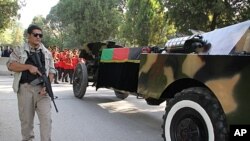Thousands of mourners helped bury Afghanistan's former president and head peace broker with the Taliban, Burhanuddin Rabbani, days after he was killed by a suicide bomber at his home.
Friday's funeral in Kabul drew large crowds of people who pushed and shoved around Rabbani's coffin. During the hilltop ceremony, dozens of Rabbani supports chanted angry slogans against the United States, Pakistan and Afghan President Hamid Karzai. Some even threw stones at Afghan security forces, prompting police to fire their guns into the air.
At one point, security guards tried to stop a Rabbani ally, former intelligence chief Amrullah Saleh, from joining the crowd. Saleh shouted angrily, "a terrorist was allowed to enter and kill our leader, but we are not allowed to attend his burial." He also vowed to take to the streets, saying the government does not have the right to talk with "enemies anymore," in a reference to Taliban reconciliation talks.
The scene was far different earlier on Friday at the presidential palace, where President Karzai told mourners that it is Afghanistan's responsibility to act against those who are "enemies of peace."
Rabbani, an ethnic Tajik, was killed Tuesday by a suicide bomber claiming to carry a reconciliation message from the Taliban. The attacker hid explosives in his turban.
The former president was the head of Afghanistan's High Peace Council and was spearheading peace efforts with the Taliban.
Many fellow Tajiks attending Rabbani's funeral on Friday vowed to avenge his death.
Rabbani became president of a shaky mujahedeen coalition government in 1992 after the collapse of the country's Soviet-backed communist government. His presidency ended in 1996, with the rise of the Taliban.
The former president then became the nominal head of the Northern Alliance, made up of Afghanistan's ethnic minorities. The alliance joined with international forces in ousting the mainly ethnic-Pashtun Taliban from power in 2001.
President Karzai said Thursday the suicide bomber had presented officials with an audio message of a purported Taliban peace offer. He said he had listened to it before leaving for New York to attend the United Nations General Assembly. Karzai cut short his U.S. trip after Rabbani's assassination.
A spokesman for the Afghan intelligence agency said Thursday officials believe the Taliban's leadership body, the Quetta Shura, was behind the assassination.
There is conflicting information regarding the claim of responsibility. A Taliban spokesman told the Reuters news agency that the group carried out the attack, but another Taliban spokesman rejected that claim and said the insurgent group would not comment on Rabbani's assassination.
Some information for this report was provided by AFP, AP and Reuters.








